tire pressure MERCEDES-BENZ E-CLASS CABRIOLET 2018 Owner's Manual
[x] Cancel search | Manufacturer: MERCEDES-BENZ, Model Year: 2018, Model line: E-CLASS CABRIOLET, Model: MERCEDES-BENZ E-CLASS CABRIOLET 2018Pages: 498, PDF Size: 6.28 MB
Page 5 of 498
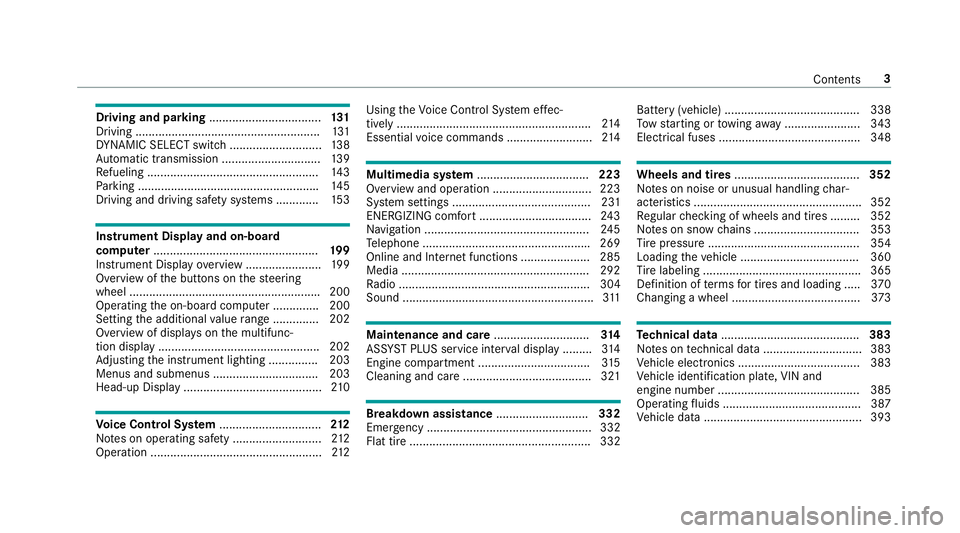
Drivingand pa rking .................................. 131
Driving ........................................................ 131
DY NA MIC SELECT switch ............................1 38
Au tomatic transmission .............................. 139
Re fueling .................................................... 143
Pa rking ...................................................... .145
Driving and driving saf etysy stems ............ .153
Instrument Display and on-board
comp uter .................................................. 199
Instrument Display overview ...................... .199
Overview of the buttons on thesteering
wheel ......................................................... .200
Operating the on-board computer .............. 200
Setting the additional value range .............. 202
Overview of displ ays on the multifunc‐
tion display ................................................ .202
Ad justing the instrument lighting ............... 203
Menus and submenus ................................ 203
Head-up Display .......................................... 210
Vo ice Control Sy stem ............................... 212
No tes on operating saf ety.......................... .212
Operation ....................................................2 12Using
theVo ice Cont rol Sy stem ef fec‐
tively ........................................................... 214
Essential voice commands .......................... 214
Multimedia sy stem .................................. 223
Overview and operation .............................. 223
Sy stem settings .......................................... 231
ENE RGIZING comfort .................................. 243
Na vigation .................................................. 245
Te lephone .................................................. .269
Online and Internet functions ..................... 285
Media .........................................................2 92
Ra dio .......................................................... 304
Sound .......................................................... 311
Maintenance and care .............................314
ASS YST PLUS service inter val display ........ .314
Engine compartment .................................. 315
Cleaning and care ...................................... .321
Breakdown assistance ............................332
Emergency .................................................. 332
Flat tire ....................................................... 332 Battery (vehicle) ......................................... 338
To
w starting or towing away ....................... 343
Electrical fuses ........................................... 348
Wheels and tires ...................................... 352
No tes on noise or unusual handling char‐
acteristics .................................................. .352
Re gular checking of wheels and tires ......... 352
No tes on snow chains ................................ 353
Ti re pressure .............................................. 354
Loading theve hicle .................................... 360
Ti re labeling ................................................ 365
Definition of term sfo r tires and loading ..... 370
Changing a wheel ...................................... .373
Tech nical data .......................................... 383
No tes on tech nical da ta.............................. 383
Ve hicle electronics .....................................3 83
Ve hicle identification plate, VIN and
engine number ...........................................3 85
Operating fluids .......................................... 387
Ve hicle data ................................................ 393
Contents 3
Page 11 of 498
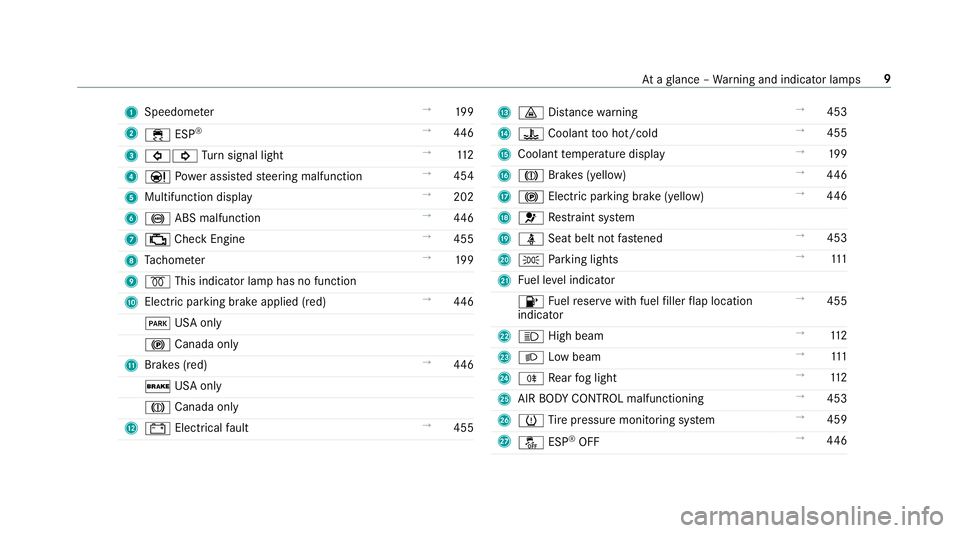
1Speedom eter →
199
2 00E5 ESP
®→
446
3 003E003D Turn signal light →
112
4 00CC Powe r assi sted steering malfunction →
454
5 Multifunction display →
202
6 0025 ABS malfunction →
446
7 00B9 Check Engine →
455
8 Tach ome ter →
199
9 0028 This indicator lamp has no function
A Elect ric park ing brake applied (red) →
446
0049 USA only
0024 Canada only
B Brakes (red) →
446
0027 USA only
004D Canada only
C 003D Electrical fault →
455
D00BA Distance warning →
453
E 00AC Coolant too hot/cold →
455
F Coolant temp erature display →
199
G 004D Brakes (yell ow) →
446
H 0024 Electric pa rking brake (yellow) →
446
I 0075 Restra int sy stem
J 00E9 Seat belt not fastened →
453
K 0060 Parking lights →
111
L Fuel le vel indicator
00B6 Fuelreser vewith fuel filler flap location
indicator →
455
M 0057 High beam →
112
N 0058 Low beam →
111
O 005E Rear fog light →
112
P AIR BODY CONTROL malfunctioning →
453
Q 0077 Tire pressure monitoring sy stem →
459
R 00BB ESP
®OFF →
446
At aglance – Warning and indicator lamps 9
Page 13 of 498
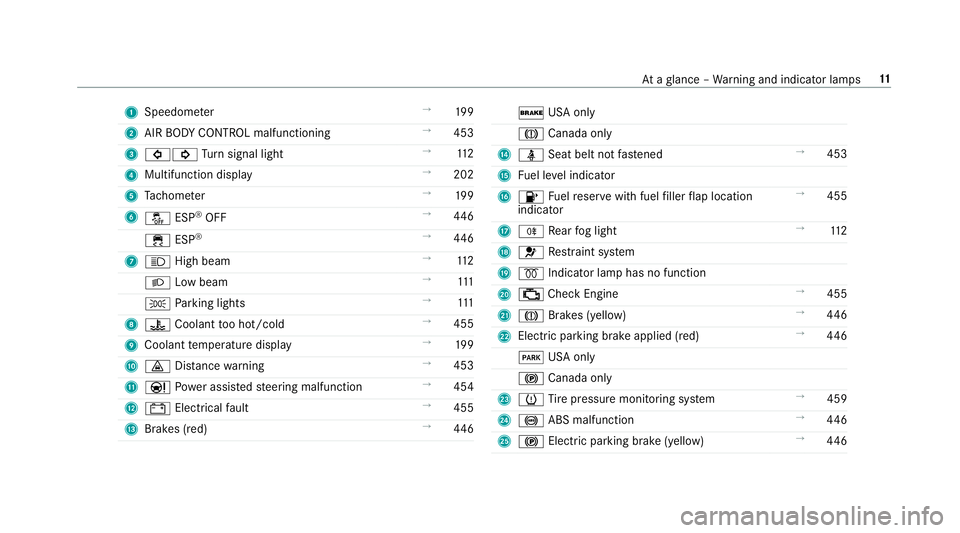
1Speedom eter →
199
2 AIR BODY CONTROL malfunctioning →
453
3 003E003D Turn signal light →
112
4 Multifunction display →
202
5 Tach ome ter →
199
6 00BB ESP
®OFF →
446
00E5 ESP
®→
446
7 0057 High beam →
112
0058 Low beam →
111
0060 Parking lights →
111
8 00AC Coolant too hot/cold →
455
9 Coolant temp erature display →
199
A 00BA Distance warning →
453
B 00CC Powe r assi sted steering malfunction →
454
C 003D Electrical fault →
455
D Brakes (red) →
446
0027 USA only
004D Canada only
E 00E9 Seat belt not fastened →
453
F Fuel le vel indicator
G 00B6 Fuelreser vewith fuel filler flap location
indicator →
455
H 005E Rear fog light →
112
I 0075 Restra int sy stem
J 0028 Indicator lamp has no function
K 00B9 Check Engine →
455
L 004D Brakes (yellow) →
446
M Electric pa rking brake applied (red) →
446
0049 USA only
0024 Canada only
N 0077 Tire pressure monitoring sy stem →
459
O 0025 ABS malfunction →
446
P 0024 Electric pa rking brake (yellow) →
446
At aglance – Warning and indicator lamps 11
Page 19 of 498

Whattodo in theeve nt of an accident
1 Safetyve sts →
332
2 Buttons forth e SOS emer gency call sy stem and
breakdown assis tance →
282
3 Checking and topping up operating fluids →
387
4 Tow- starting and towing away →
344
5 Flat tire →
3326Starting assis tance →
340
7 Haza rdwa rning lights →
113
8 Fuelfiller flap with instruction labels for tire
pressure , fuel type and QR code for accessing
th ere scue card →
143
9 Tow- starting and towing away →
344
A TIREFIT kit →
334
Ataglance – Emer gencies and breakdowns 17
Page 21 of 498
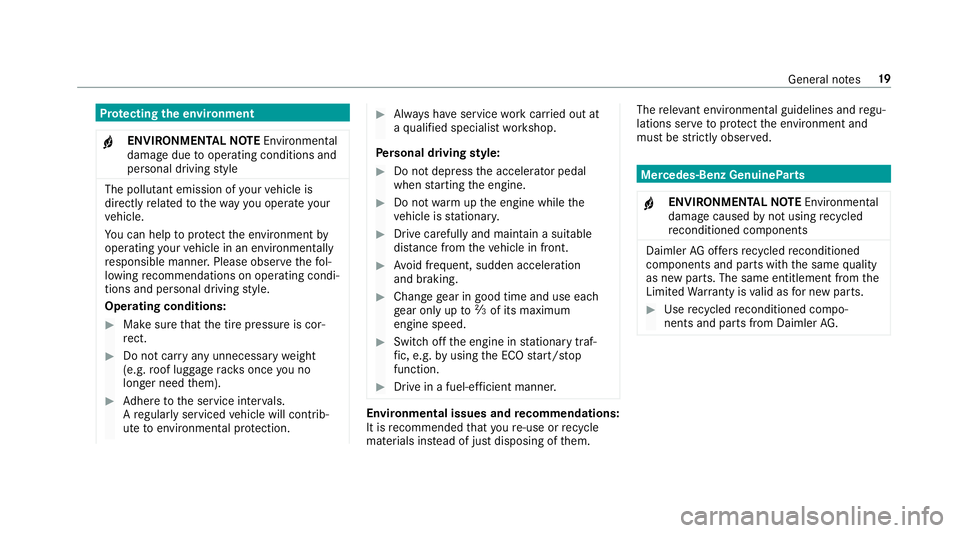
Protecting the environment
00D2ENVIRONMENTAL NOTEEnvironmental
damage duetooperating conditions and
personal driving style
The pollutant emission of your vehicle is
directly related tothewa yyo u operate your
ve hicle.
Yo u can help toprotect the environment by
operating your vehicle in an environmentally
re sponsible manner. Please obser vethefo l‐
lowing recommendations on ope rating condi‐
tions and pe rsonal driving style.
Operating conditions:
00BBMake sure that the tire pressure is cor‐
re ct.
00BBDo not car ryany unnecessary weight
(e.g. roof luggage rack s once you no
longe r need them).
00BBAd here tothe service inter vals.
A regularly serviced vehicle will contri b‐
ute toenvironmen tal pr otection.
00BBAlw ays ha veservice workcar ried out at
a qu alified specialist workshop.
Pe rsonal driving style:
00BBDo not depress the accelera tor pedal
when starting the engine.
00BBDo not warm upthe engine while the
ve hicle is stationar y.
00BBDrive carefully and maintain a suitable
dist ance from theve hicle in front.
00BBAv oid frequent, sudden acceleration
and braking.
00BBChange gear in good time and use each
ge ar only upto00C3 of its maximum
engine speed.
00BBSwitch off the engine in stationary traf‐
fi c, e.g. byusing the ECO start/ stop
function.
00BBDrive in a fuel-ef ficient manne r.
Environmental issues and recommendations:
It is recommended that youre -use or recycle
materials ins tead of just disposing of them. The
releva nt environmental guidelines and regu‐
lations ser vetoprotect the environment and
must be strictly obser ved.
Mercedes-Benz GenuineParts
00D2ENVIRONMEN TALNO TEEnvironmental
damage causedbynot using recycled
re conditioned components
Daimler AGoffers recycled reconditioned
components and part s withthe same quality
as new parts. The same entitlement from the
Limited Warranty is valid as for new parts.
00BBUse recycled reconditioned compo‐
nents and part s from Daimler AG.
Gene ral no tes 19
Page 28 of 498

If NHTSAreceive s similar complaints, it may
open an in vestigation, and if it finds that a saf ety
defect exists in a groupof vehicles, it may order
a re call and remedy campaign. Ho wever,NHT SA
cannot become in volved in individual problems
between you, your dealer, or Mercedes-Benz
US A,LLC.
To contact NHT SA,yo u may call theVe hicle
Saf etyHotlin eto ll-f ree at 1-888-327-4236
(TT Y:1-800-424-9 153) (inside the USA); go to
http://www.safercar.gov; or write to:Ad minis‐
trator, NHT SA, 400 Se venth Street,SW .,Wa sh‐
ington, DC 20590, US A.
Fu rther information on vehicle saf etycan be
fo und at: http:/ /www.safercar.g ov
LimitedWarranty
0075 NO
TEDama getotheve hicle arising
from violation of these operating instruc‐
tions.
Damage totheve hicle can arise from viola‐
tion of these operating instructions.
This damage is not co vered either bythe
Mercedes-Benz implied warranty or bythe
New‑ or Used- Vehicle Warrant y.
00BBFollow the instructions in these operat‐
ing instructions on proper operation of
yo ur vehicle as well as on possible vehi‐
cle damage.
QR codes for the rescue card
The QR code is secured in the fuel filler flap and
on the opposite side on the B-pillar. In theeve nt
of an accident, rescue services can use the QR
code toquickly find the appropriate rescue card
fo ryo ur vehicle. The cur rent rescue card con‐
ta ins the most impor tant information about your
ve hicle in a compact form , e.g. thero uting of the
electric lines.
Fu rther information can be obtained at http://
www.mercedes-benz.de/qr-code.
Ve hicle data storage
Information from electronic control units
Yo ur vehicle is equipped with electronic contro l
units. Some of these are necessary forth e safe
operation of your vehicle, while some assist you
when driving (driver assis tance sy stems). In
addition, your vehicle pr ovides con venience and
enter tainment functions, which are also made
possible byelectronic control units.
Elect ronic control units contain da tamemories
which cantemp orarily or permanently store
te ch nical information about theve hicle's operat‐
ing status, component loads, mainte nance
re qu irements and tech nical events or malfunc‐
tions.
In general, this information documents thest ate
of a component part, a module, a sy stem or the
sur roundings, forex ample:
Roperating statuses of sy stem components
(e.g. fluid leve ls, battery status, tire pressure)
Rstatus messages concerning theve hicle and
its individual components (e.g. number of
wheel revo lutions/speed, decele ration, lat‐
26
General no tes
Page 136 of 498

Running-in no tes
To preser vethe engine during thefirs t
1, 000 miles (1,500 km):
Rdrive at varying road speeds and engine
speeds.
Rdrive in drive program Cor E.
Rchange gear before there v counter needle is
00C3 ofthewa yto there d area of there v coun‐
te r.
Rdo not shift down a gear manually in order to
brake.
Rav oid overstraining theve hicle, e.g. driving at
full thro ttle.
Rdo not depress the accelerator pedal past
th e pressure point (kickdown).
Ronly increase the engine speed gradually and
accelerate theve hicle tofull speed af ter
1, 000 miles (1,500 km).
This also applies when the engine or parts of the
driv etra in ha vebeen replaced. Please also obser
vethefo llowing running-in
no tes:
RIn cer tain driving and driving saf etysy stems,
th e sensors adjust automatically while a cer‐
ta in dis tance is driven af terth eve hicle has
been delivered or af terre pairs. Full sy stem
ef fectiveness is not achie ved until the end of
th is teach-in process.
RBrake pads, brake discs and tires that are
either new or ha vebeen replaced only ach‐
ie ve optimum braking ef fect and grip af ter
se veral hundred kilom eters of driving. Com‐
pensate forth ere duced braking ef fect by
applying greater fo
rc eto the brake pedal.
Note s on driving
0071
WARNING Risk of accident due to
objects in the driver's foot we ll
Objects in the driver's foot we ll may impede
pedal tra vel or block a depressed pedal.
This jeopardizes the operating and road
saf etyof theve hicle.
00BBStow all objects in theve hicle securely
so that they cannot getinto the driver's
fo ot we ll.
00BBAlw ays ins tallth efloor mats securely
and as prescribed in order toensure
th at there is alw ays suf ficient room for
th e pedals.
00BBDo not use loose floor mats and do not
place floor mats on top of one ano ther.
0071
WARNING Risk of accident due to
unsuit ablefoot we ar
Operation of the pedals may be restricted
due tounsuit ablefoot we ar such as:
RShoes with platfo rmsoles
RShoes with high heels
RSlippers
00BBWhen driving alw ayswe ar suitable
shoes in order tobe able tooperate the
pedals safel y.
134
Driving and pa rking
Page 156 of 498

Overview of driving systems and driving
saf ety sy stems
In this section, youwill find information about
th efo llowing driving sy stems and driving saf ety
sy stems:
R360° Camera (→page 181)
RABS ( Anti-lock Braking Sys tem)
(→page 154)
RAc tive Dis tance Assist DISTRONIC
(→pa ge 162)
RAIR BODY CONTROL (→page 171)
RAc tive Brake Assi st(→page 156)
RAc tive Lane Keeping Assist (→page 195)
RATTENTION ASSIST (→page 189)
RBA S (Brak eAssist System) (→page 154)
REBD ( Electronic Brakeforc eDistribution)
(→page 155)
RESP®(E lectronic Sta bility Program)
RHill Start Assist
RHOLD function (→page 170)
RSTEER CONTROL (→page 155)
RAc tive Steering Assist (→page 167)
RAc tive Parking Assist (→page 184)
RParking Assist PARKTRONI C (→page17 5)
RRe ar view camera (→page 178)
RCruis e control (→page 160)
RBlind Spot Assist and Active Blind Spot Assi st
(→page 193)
RTraf fic Sign Assist (→page191)
Fu nctions of ABS (Anti-lock Brake Sy stem)
ABS regulates the brake pressure in critical driv‐
ing situations:
RDuring braking, e.g. at maximum full-s top
braking or insuf ficient traction of the tires,
th e wheels are pr evented from blocking.
RVehicle steerability while braking is ensured.
If ABS inter venes when braking, you will feel a
pulsing in the brake pedal. The pulsating brake
pedal can be an indication of hazardous road
conditions and can ser veas a reminder totake
ex tra care while driving. Sy
stem limitations
RABS is active from speeds of appr ox. 5 mph
(8 km/h).
RABS may be impaired or may not function if a
malfunction has occur red and theye l‐
low 0025 ABSwarning lamp lights up contin‐
uously in the instrument clus ter af terth e
engine is star ted.
Fu nction of BAS (Brake Assist Sy stem)
0071
WARNING Risk of an accident caused by
a malfunction in BAS (Brake Assist Sys‐
te m)
If BA S is malfunctioning, the braking dis tance
in an eme rgency braking situation is
increased.
00BBDepress the brake pedal with full forc e
in emer gency braking situations. ABS
pr eve nts the wheels from locking.
BA S suppo rts yo ur eme rgency braking situation
with additional brake forc e.
15 4
Driving and pa rking
Page 161 of 498
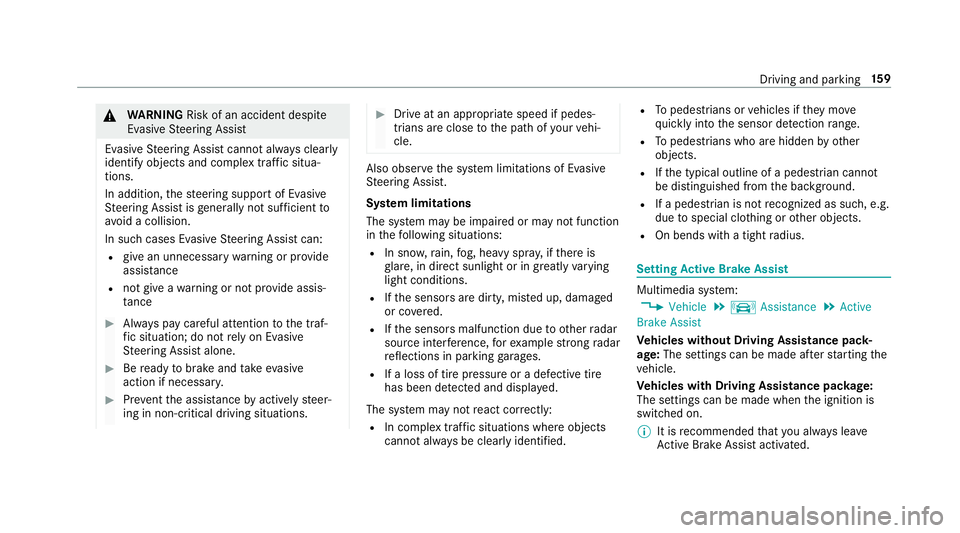
0071WARNING Risk of an accident despite
Evasive Steering Assist
Evasive Steering Assist cannot always clearly
identify objects and complex traf fic situa‐
tions.
In addition, thesteering support of Evasive
St eering Assist is general lynot suff icientto
avo id a collision.
In such cases Evasive Steering Assist can:
Rgive an unnecessary warning or pr ovide
assis tance
Rnot give awa rning or not pr ovide assis‐
ta nce
00BBAlw ays pay careful attention tothe traf‐
fi c situation; do not rely on Ev asive
St eering Assist alone.
00BBBe ready tobrake and take evasive
action if necessar y.
00BBPreve ntthe assis tance byactively steer‐
ing in non-critical driving situations.
00BBDrive at an appropriate speed if pedes‐
trians are close tothe path of your vehi‐
cle.
Also obser vethe sy stem limitations of Evasive
St eering Assist.
Sy stem limitations
The sy stem may be impaired or may not function
in thefo llowing situations:
RIn sno w,rain, fog, heavy spr ay, if there is
gl are, in direct sunlight or in greatlyvarying
light conditions.
RIf th e sensors are dirty, mis ted up, damaged
or co vered.
RIfth e sensors malfunction due to otherradar
source inter fere nce, forex ample stro ng radar
re flections in parking garage s.
RIf a loss of tire pressure or a defective tire
has been de tected and displ ayed.
The sy stem may not react cor rectly:
RIn complex traffic situations whe reobjects
cannot always be clearly identified.
RTo pedestrians or vehicles if they mo ve
qu ickly into the sensor de tection range.
RTo pedestrians who are hidden by other
objects.
RIf th e typical outline of a pedestrian cannot
be distinguished from the bac kground.
RIf a pedestrian isnot recognized as such , e.g.
due tospecial clo thing or other objects.
ROn bends with a tight radius.
Setting Active Brake Assi st
Multimedia system:
0086�9�H�K�L�F�O�H00CFk �$�V�V�L�V�W�D�Q�F�H00CF�$�F�W�L�Y�H
�%�U�D�N�H �$�V�V�L�V�W
Ve hicles without Driving Assistance pack‐
age: The settings can be made af terst arting the
ve hicle.
Ve hicles with Driving Assistance pac kage:
The settings can be made when the ignition is
switched on.
00CE It is recommended that you alw ays lea ve
Ac tive Brake Assi stactivated.
Driving and parking 15
9
Page 196 of 498
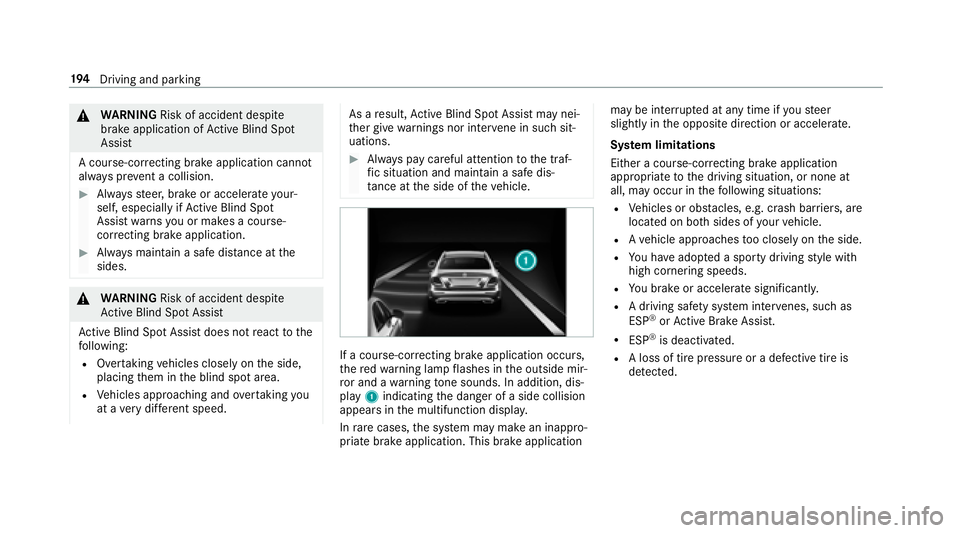
0071WARNING Risk of accident despite
brake application of Active Blind Spot
Assi st
A cours e-correcting brake application cannot
alw ays pr event a collision.
00BBAlw aysst eer, brake or accelera teyour‐
self, especially ifAc tive Blind Spot
Assi stwa rnsyo u or makes a course-
co rrecting brake application.
00BBAlw ays maintain a safe dis tance at the
sides.
0071 WARNING Risk of accident despite
Ac tive Blind Spot Assi st
Ac tive Blind Spot Assi stdoes not react tothe
fo llowing:
ROver taking vehicles closely on the side,
placing them in the blind spot area.
RVe hicles approaching and overtaking you
at a very differe nt speed.
As a result, Active Blind Spot Assi stmay nei‐
th er give warnings nor inter vene in such sit‐
uations.
00BBAlw ays pay careful attention tothe traf‐
fi c situation and maintain a safe dis‐
ta nce at the side of theve hicle.
If a course-cor recting brake application occurs ,
th ere dwa rning lamp flashes in the outside mir‐
ro r and a warning tone sounds. In addition, dis‐
pl ay 1 indicating the danger of a side collision
appears in the multifunction displa y.
In rare cases, the sy stem may make an inappro‐
priate brake application. This brake application may be inter
rupte d at any time if yousteer
slightly in the opposite direction or accelera te.
Sy stem limitations
Either a course-cor recting brake application
appropria teto the driving situation, or none at
all, may occur in thefo llowing situations:
RVe hicles or obs tacles, e.g. crash barr iers, are
located on bo thsides of your vehicle.
RAve hicle approaches too closely on the side.
RYo u ha veadop ted a sporty driving style with
high cornering speeds.
RYo u brake or accelerate significantl y.
RA driving safety system inter venes, such as
ESP®or Active Brake Assi st.
RESP®is deacti vated.
RA loss of tire pressure or a defective tire is
de tected.
19 4
Driving and pa rking